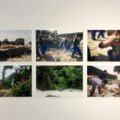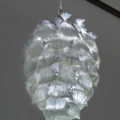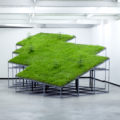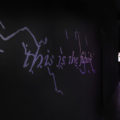Afterimage and Aura: Liminal Art by Gary Hill
In the history of Visual Art, image has constantly integrated with text, such as early Egyptian frescoes, medieval religious paintings with Bible quotations, and 20th century cubist paintings. There were the works that images and languages would complement each other so as to achieve the true expression. However, in the latter half of the 20th century, the Post-Structuralist proclaimed that the real object has never been existed, they’re merely the structure which constructed by symbols such as language and images. When confronting the “representation crisis”, the effects of images and texts in visual arts would have to be altered accordingly.
Gary Hill, known for his singular integration of video, sound, performance and installation, has been conducting multi-layered investigation on the nature of phenomenology through visual, auditory and language signal networks to understand how people perceive the world. To a certain extent, he was influenced by the conceptual art of the 1970s, that is, thoughts revolve around language rather than images. Hill’s works not only explore language, but also explore symbolic images. As he reiterated, artistic creation should focus on the symbolic process and reveal the unreliability of the logical creation mechanism on which the world value system is based. Therefore, Hill’s creation since 1980s can be called meta-semiotic creations.
The connection between languages and images has always been the fundamental theme of Hill’s art, for example the Primarily Speaking (1981-1983) and Incidence of Catastrophe (1988). In his Electronic Linguistics (1977). Hill attempted to apply the speedy, serial motions of electron images to elaborate the visual appearance of certain electronic sound, regarding the images as a language, a linguistic text with images as representations.
Ever since1970, in his art practice, Hill took videos and extended electronic media to be the central role in his artworks by using the formal structure of this specific media to inspect or destruct the power of the images. Considering the increasingly unified visual art culture, Hill expounded the major communication functions of electronic media by deconstructing and reorganizing sound, speed, sequence and light, causing not only a substantial disruption to the perceptual norm but also bringing about a new way of encountering meaning —to withstand, accumulate, absorb or yield within.
In the “Greater Taipei Biennial of Contemporary Art: SNAPS OMNI EXPO,” orchestrate by National Taiwan University of Arts, held from Nov 8, 2019 to Jan 12, 2020, Gary Hill was invited to exhibit three of his most prominent installations in recent years. Combining language and body as core elements in artistic creation, these works question the content of perception through the cracks in the images. In Pacifier, Choir Box, and This Slow Torque of Bonsai, by liberating the relationships between words and their meanings, Hill created “visual poetics”, which changes the way of viewing and understanding artworks, and arouse people’s attention to the invisible space between the work and the spectators. As the viewers follow the artist with visual images to feel the voice changes of words, the screens follow the changes of each syllable of the human voice. They are no longer placed in front of the artwork, rather, surrounded by the work, occupying an internal space of the image. This sense of envelopment is very close to daily life scenes. The boundary between real space and natural space becomes blurred. Technology’s imitation of external reality brings viewers a critical experience of virtual space. As viewers follow the artist’s images to sense the variety in the sound of the language, the screens change with each syllable of the human voice. The viewers no longer place themselves in front of the artwork, rather, are surrounded by the creation, occupying an internal space of the image. The sense of envelopment, close to our everyday life scenes, make the boundary between real space and natural space vague. The simulation of external reality with technology brings the viewers liminal experience of virtual space.(1)
For a long time, after Hill has explored the cognitive and sensory conditions that form the basis of our discourse communication methods, Hill has carried some experiments on the material and acoustic characteristics of language, In order to meditate on the meaning produced in our day-to-day context and highly personal poetic space. His video and installation art challenge our perspective on the inertial vision of WYIWYG by showing the intermediary nature of the interaction between viewer and the artworks. Hill thoroughly studied the relationship between body, words, images and technology, and in this way he open up a perceptual space in which to explore the themes of the spectators oscillating among all these relations.
Along with the exploration of the liminality (sensory threshold) when verging on the systematic order and chaotic disorder, those non-linear forms, the occurrence of self-organization and self-shaping as well as the paradigm released from virtual and neoteric dynamics, Hill’s contemporary art practice therein has further strengthened the perception of Marcel Duchamp as in “Art is a road that leads the territory which would never be dominated by time and space.” Hereupon, to define an art work to be a “liminality” one means that it is a critical presentation and a foreshadowing of a change in perspective; that is to say, the reality with a restless completeness would be made incomplete. In the sense of Autopoiesis as well as non-repeatability, liminal art is a living vitally.
Primarily speaking (2), Gary Hill’s work marks a key “phase shift” in contemporary art creation. Along with the exploration of the critical “liminality” (3) of the transition between orderly systems and chaos, various nonlinear forms, the occurrence of self-organization and self-generation as well as the paradigm of the virtual and neo-dynamics released, Hill’s contemporary art practice therein has further strengthened the perception of Marcel Duchamp as in “Art is a road that leads the territory no longer dominated by time and space.” Hereupon, the significance of the concept of defining a work of art as a “liminality” is that it is a manifestation of criticality on a principle level, heralding a shift in perspective; ; that is, through the fact of endless integrity, It becomes incomplete. In the sense of self-regeneration and non-repetition, the critical art of liminality is “living vitally”.
- Pacifier (2019)
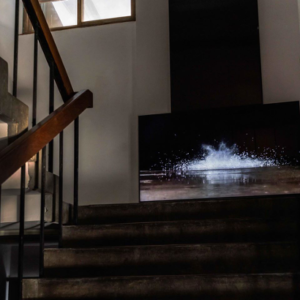
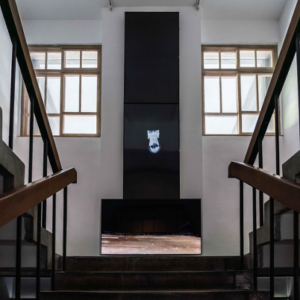
On the wall of the staircase leading to the second floor, a video installation Pacifier by Hill was exhibited. This is an alternative triptych composed of three identical HD flat screens (70”) mounted on the white wall, with two wooden framed windows on each side. The bright sky outside the window gave a relaxing atmosphere, yet the triptych screen with black background began to play a white bomb shape, falling down at a very slow speed. The slow falling process was accompanied by continuous sound effects, a cyclic Shepar falling tone (4), symbolized as an air raid during wars. As a result, the audience finally saw deconstruction, a process of slow devastation from the symbol of ultimate power to the broken and finally scattered glass shards
In fact, this is a glass atomic bomb (5) that implies power, dropped from a height of 30 feet and crashing on the ground while filmed with a high-speed camera, were eventually disintegrated into countless fragments of glass. Here, when this process is played back at a slow speed, spectators would generate divergent senses of “expectation”, in which the white bomb-shaped image becomes a multifaceted medium, constantly fluctuating between an unimaginable disaster and the fragility of the glass itself. Pacifier, the name of this artwork, also means a “pacifier” that makes children stop crying, and the shape resembles an atomic bomb, triggering the commencement for reflection on life and death. The work played the role of contact explosion, climax, and transition between one state and another at a slow speed.
In a sense, even in Pacifier, the darkness may not never be alienated. Likewise, the liminality that exists between light and darkness is indeed fertile land. Perhaps the collapse between light and darkness may be similar to the split between different species. Sometimes we feel that we are incompatible with beasts, however, at some point we hold that humans are all uncanny living creatures on the planet.
- Choir Box (2019)
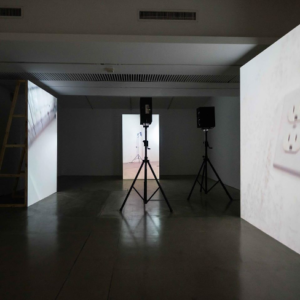
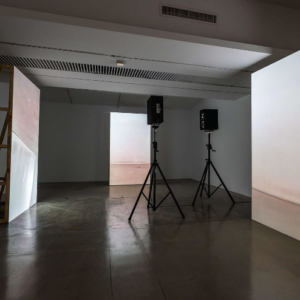
Entering the exhibition hall, visitors will see the video installation Choir Box projected on the wall. Since the projections are practically the same color as the wall, the structure of the building becomes the theme of the work. Although it turns out that this is a sense of separation from outside, yet seems to generate an ambiguous spatial-temporal breakthrough.
In the space enclosed by three standing wooden walls, with vocal choirs in a confined surrounding, beholders were immersed in the sound-impact viewing, “viewing” penetrated the vision bound by imagination, and the subject appeared to enter the wall-enclosing in the video, with the figure of a person or a certain creature or even an AI machine, approaching every possible lime wall in any way possible, exploring mottled corners as well as the angles erratically upside-down, to discover seams, crevices, wall sockets, while spectators would undergo or be confused and began to take the illusory Choir Box as another world existing either within or outside the solid walls right at the moment and the place. The subject and the guest are no longer obsessed with interaction in the circling, because all the boundaries have been wiped out in the chorus, and the New World of locating (Bravo!) has not yet begun.
Actually, the images, in their sequences of vitality and speediness, projected on three full-height walls, was the artist’s studio in Seattle, while the lens of a video camera fixed on the remote-control equipment, mapping on fringe of the studio’s floor where the ground space were left empty. Whenever the camera lens approach the wall in close-up, a ghostly chorus swooped up and then the pitch decreased as it move away. It is comparable to his well-known work Wall Piece (2000) in which the artist threw himself at the wall forcefully and repeatedly, speaking one single word at a time. With the impact of physical barrier to the sound, ripple of claustrophobia could be felt. Facing the “box” where humans cannot think and escape from the reality of existence, the voice seems to scream in in disheartenment.
Here, scenes of the artist’s studio were projected on a gallery’s wall as if the reality and the virtual are woven into an overlapping state where there is a distancing effect due to the consequent of sounds. In this video/sound installation, the artist cannot be seen in person, but the viewer feels that he is present. Because of the inertia of the listening mode (6) and the uniqueness of the vocal ontology (7), when people hear a human voice, they will be connected to the sense of “presence” of the sound owner. Even though there are so many works in which human voices stored merely in the audio file then played in the exhibition or on the stage, the subject that makes the voice can still create many singular meanings in the artwork. (8)
The information that the viewer believes they see from the screen is actually given to the image by the auditory element, a way of sound guiding or even defining the image being viewed. In Gary Hill’s work, the connection with the technical means of video/sound and other forms of production (usually direct intervention in the state of consciousness) is ubiquitous, and they become the subject of the work to some extent. The real existence of a thing escapes its authenticity (unity with the concept of the thing itself) by making it its own structure without losing its concreteness.
- This Slow Torque of Bonsai (2019)
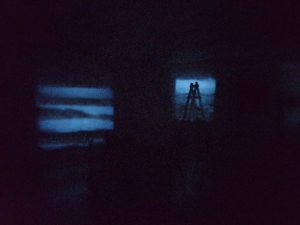
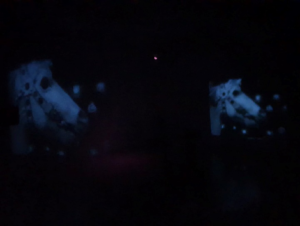
The on-and-off light becomes an opportunity to awake the temporary auto-stop flash that interrupt the images and the incidence matrix of single words. With the glitter excited in the nervous system, it is not only the connotation but also its deconstructing and discharging of one’s experience.
In this completely dark space, visitors were taken into a dream state for more than half an hour, wherein text fragments, slight impacts and projected images were contained. These images seem recount a story, but when people want to reconstruct them, they were all gone. The memories faded, the sound silenced, the images disappeared, yet the intensity of spatial feeling remained powerfully. When the audience entered the dark space constructed by Hill, were initially confused. As the eyes gradually adapted to the dimness, visitors began to notice that the surroundings are faintly visible, which are projections on three walls. These illusions of diffuse proximity enabled the viewer to establish a mirror-relationship, whether they are real or other reflections. What the visitor experienced was a profound experience, in which the mental projection of perception and cognition was activated. The artist creates an intense interactive installation in the dark, challenging the viewer to face the mystery of memory and perception, weaving the two together to show an embodied experience, instead of an object of contemplation.
Among them, the stroboscopic light becomes an opportunity to awaken the correlation matrix of images and words temporarily interrupted by the flash itself. The light of the nervous system stimulated is not only the foundation of the experience itself, but also its deconstruction and release. In the darkness, the stroboscopic flash become an opportunity to awaken the correlation matrix of images and words momentarily interrupted by the flash itself. The neurological light stimulated is not only the underlie of the experience itself, but also its deconstruction and liberation. (9)
Hill’s works are evidently rather a space for mediating and negotiating than the idea of “seeing is not what you get”. It is a space for the objective viewers. Of all the intervened installment, viewer’s body substitutes as the mediator. With the installed exhibition in a dark-room space, viewers begin to wonder if it is from the monitor above the beam or his own soul.
Is he strolling in the countryside or forest?Is it the nostalgia images overlapped as a brick-wall-vein on a HD monitor? This is how to draw a distinction among the artist’s illusory images projected, the room space and the imagination of the viewer himself. To Confuse its spectators is what liminal art is for. This is a story about telling a story. To be more specific, a story about when and where to tell this story. The viewers become a story teller who tried so hard to turn the specific experience into words so as to follow the starting point of interpretation according to images and sounds.
Obviously, in Hill’s art, what you see is not what you get, but a space for mediation and negotiation, which is the space where the subject/viewer enters. In these interventions, the body of the visitor replaced the mediation. In the dark room set up in the exhibition hall, visitors began to wonder whether what they saw came from the video projector installed on the upper beam or from their own souls. — Does the person stroll in the countryside or forest? Does the nostalgic memory appear as a brick wall texture overlapping interactive images? How to distinguish the artist’s dreamy video, room space and the viewer’s own imagination? Puzzlement is what liminal art is for. This is a story about reading a story. To be precisely, a story is the time and space of the room where the story is told. The viewer is a storyteller, who tries hard to read this experience as language to follow the images and sounds to the beginning of meaning.
This story may have already begun…Beside me…under the influence of images..
By watching, arranging the rhythm, and listening, it seems to be about forgetting and some kind of passing memory, wandering in a dark room, some objects are scattered on the ground, visitors can stand or walk, while avoiding possible collisions, words and sentences and images in the dark Shows and fades alternately in the middle, each time the strobe light flashes and goes out, leaving an afterimage in the viewer’s mind.
Viewers are making every effort to gaze at the surrounding walls where some blurred photos displayed including horses, female faces, wilderness, trees, and seashore. The strobe light lights up the space and then dies out. The strobe light brightened the room, and then again, the space sinks into darkness. Since without the distraction of light, these words and sentences are actually stated matter-of-factly, with such loose and extended phrasing that the narrative thread is lost; the meaning of stories is as distant as a passing memory. Just like a dimly lit image, the sound from time to time does not allow the viewer to listen attentively, so that the story cannot be pieced together into an intelligible story, and everything seems blurred.
By watching, arranging the rhythm, and listening, it seem to be about forgetting and some kinds of passing memory, wandering in a dark room, while some gadgets were scattered on the ground, and visitors stood or walked, avoiding possible collisions. In the dimness, phrases reciting and images displaying alternately occurred and faded, and every time the strobe light flashed on and off, would leave the afterimages in the viewer’s mind.
Our past trajectories/ …The slow torque of bonsai/ …I brought you here for reasons I can’t disclose / I’ve worked long hours for this / There is no particular agenda in mind / Nothing here will make or break/ Anything⋯⋯
(voice-over)
The viewers, in a darken space, lingered for watching, after-strobing afterimage, shadowed images, murmuring in the cracks, and then-flashes! –Strobe flash. The light source from projected images reveals, or conceal, the visible and invisible aura inside the afterimages.
Throughout the entire depth of this work, it is not the plot, but the afterimage after the strobe. The wall of the exhibition hall is like an opaque screen, with the light in the video images, revealing the girders, beams and human space of the gallery, and projecting the space outside the image. After the intense stroboscopic lighting moment, the afterimage of the retina of the visitors merged with the subsequent ghost illusion. While the projected images moved between the walls, people felt hovering among them, longing for meanings.
From the dynamics of encounters between the viewer and the light characters that appear in the path of the video installation, each image is treated as a syllable, and the montage is paired with others in succession, forming sentences. The video would seem to affirm, therefore, that the image is constructed as the language. Hill seems to play with the editing, just like in the post-structural cinema as in video, here the agency of images and words serves the significance, building this curious effect of language that is a writing, and inviting the viewer to a disturbing adventure in the dark.
This Slow Torque of Bonsai incorporate strobe lights that have the ability to emit pulses of hyper-intense light and allow create extended afterimages. These afterimages are superimposed on projected images that have extremely low light, generating on the perceptual memory in an indescribable way. When they are related to isolated spoken phrases that accumulate over time, the process of memory itself becomes a kind of narrative in itself and about itself. In other words, it is a mix between an image ‘recorded’ in the eye/brain and another that is being ‘seen’ in real space. It’s an extension of the ‘post-screen’ concept; alternatively, we could think of it as a pre-screen (before the image).
In a related way, This Slow Torque of Bonsai creates an explicit psychic field. Concretely, the space is the viewer’s “visual psyche” what one sees with one’s eyes closed(dream or hypnogogic or meditated visual appearances). The strobic interruptions simulate such psychic appearances, so that viewers cognize what they see as if this were emissions of their own psyche.
The images appear on a screen that is surrounded by darkness, although it’s impossibile to figure out how far away the screen is. The strobic flashes instantly show the presence of the screen, and leave an afterimage on the retina. In fact, it becomes paradoxically the only information outside of one’s sensorium . The afterimage fades; new images appear on the screen but only in the haze of that fading afterimage. Psychological internal and physically external image sources experientially merge.
Beyond the afterimages, the “enigmatic signifiers” were anchored in the viewer’s mind, referring to the forgotten visual and language traces, and the retrospective fantasy which is always in an unstable cycle, “an opposite movie.” Among them, even though the capacity to transmit its content has been lost, nonetheless its interpellative force retained, its capacity to address the subject. Such a message signals that there is some meaning in it that is not being transmitted, that some secret is withheld from communication, and message therefore comes through to the recipient as a mysterious enigma that demands to be deciphered. This is how Hill moves smoothly to using This Slow Torque of Bonsai, with various kinds of visible and invisible things, as a metaphor for the otherness of the unconscious, which is likened.
As a projected domain of human experience, the singularity of Hill’s work creates a context of aesthetic experience, evokes the viewer’s inner emotional subjectivity through afterimages. It is an all new sort of electro-gestural ontology seemingly. It bears visual and verbal image-events with parable-like momentum, as if a sacred being or memory ought to be behind these pithy sayings. A certain intense insinuation in the voice stands in awe before its own vision, which, although dream-like, engendered within the physical medium of vision, thence coming forward into liminal view.
- Conclusion: The Return to Aura
In Hill’s artwork, the spatiality and temporality arouses on the conjunction of the fragments. This reminds pure memory as Proust names it involuntary memory, inscribed in body or in unconscious. Confronting such an image, we, as the viewers may be suspended placeless as body. However the viewers sustain the relation of space and time constituted in their own body, with the practice of reading the given abstract body image in different duration. The space with all its temporalities is regained by site-specific art for the viewer. Thus, it is possible to say that the viewer is replaced in the image revealing an experience between perception and recollection, between the images within the space of the work and recipient/interacter’s memory compiled with the time.
Herein, the reproduction of the aura is formulated as an experience of the subject for the duration of the work, in which the view’s gaze is returned from what’s been looking at. This proposed experience includes the viewer’s involvement and interaction. The duration is introduced here as a consequence of the distance either decreasing or increasing. The viewer is looking at and yet being looked. Thus, duration of the perception leads to memory in which the viewer recalls the past experiences in comparison to what he/she encounters. Hence, being in the picture is what site-specificity suggests as encountering its space and time. This is the experience in which the viewer will recollect. The dual cooperation of the image and the memory will let the viewer oscillate from the image and to his/her memory and from the memory to the image again. (11) This continuous oscillation is the reproduced aura experience, which is a return to aura.
Footnotes:
(1) With influenced on reading Maurice Blanchot’s books, Gary Hill often uses phenomenological experience to confront the idea of how language interferes with reality. These background knowledges enriched his poetic visual experiments about the relations and connections among language, images, position and body.
(2) Primarily Speaking is an important video art work by Hill in 1981-1983
(3) Liminality is a concept and cognitive frame where we sense and percept the relation between core and periphery. There are the framing behaviors, a signal indeed, enable us to detect under an objective condition of withdrawal and reflectivity with a vacillated interaction toward those inimaginable surrounding at certain point of the process.
(4) Shepard tone is the sound consisting of a superposition of sine waves an octave apart. By playing the lowest-note of the tone upward or downward, it is referred to as the Shepard scale. As an audio illusion, seemingly ascending or descending continually while the pitch never gets higher or lower genuinely.
(5) From its title to the imaginary, one cannot but recall the atomic bombings in Hiroshima, Japan, 1945. The work is entitled " Fat Man".
(6) Chion, M. (2012). The three listening modes. The Sound Studies Reader, 48-53.
(7) Cavarero, A. (2005). For more than one voice: Toward a philosophy of vocal expression. Stanford University Press.
(8) The sense of presence becomes a kind of presence. The audience would never be satisfied with the concepts such as "where?", "who is there?" or any other concept like "what is the sequence of occurrence?". Somehow, they still feel something in the body that may be even more practical than what they see. In gazing and listening respectfully, what is a performance space? Where is physical boundary and limitation for perception toward things in your mind? The absolute existence which mingles with the blindness will or will not exist and becoming a process of mediation.
(9) Quasha, G., & Stein, C. (Eds.). (2009). An Art of Limina: Gary Hill's Works and Writings. Poligrafa Ediciones Sa.
(10) Just like the example of Proust’s experience as proposed by W. Benjamin, memory is essentially an experience, which cannot be separable either from the collective past/experience or individual past/experience but rather is formed by the combination of both



